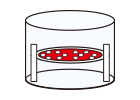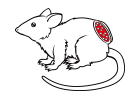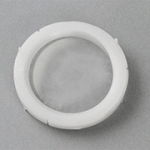
Atelocollagen, Permeable Membrane for 50 mm Culture Dish
The atelocollagen permeable membrane scaffold is suitable for culturing primary epithelial cells. Conventional plastic and glass-based cultureware does not take into account the polarity of cells. In contrast, this permeable membrane enables cells to maintain their polarity during cell culture. This membrane is also useful in cell-cell interaction studies.
Application and Features
 |
 |
 |
| Culture on membrane | Co-culture | Cell sheet transplantation |
- Since the collagen membrane is fully permeable to small molecules, cells cultured on this membrane will maintain their polarity and absorb nutrients/excrete metabolic waste products across the membrane.
- Because the membrane is transparent, microscopic observation of the cells is possible during culture.
- Two different cell types can be cultured, one on each side of the membrane, and this membrane is particularly useful for cell-cell interaction studies without direct cell-cell contact.
Types of collagen
Bovine hide derived atelocollagen
Frequently Asked Questions
How can I seed cells on Atelocollagen membrane?
Please visit our distributors’ page to download an instruction manual
Why do I have to neutralize Atelocollagen membrane before use?
The membrane is made from atelocollagen acidic solution and neutralization is necessary prior to cell culture.
How can I harvest cells from Atelocollagen membrane?
Use a cell scraper to harvest cells. We have confirmed that the membrane will not degrade upon treatment with lysis buffers contained in nucleic acid extraction kits.
Is it possible to prepare sections from Atelocollagen membrane?
Similar to tissue samples, Atelocollagen membrane can be fixed and/or embedded in paraffin/OCT compound.
How can I observe cells on Atelocollagen membrane?
Cells can be observed using a phase-contrast microscope. We recommend labelling cells beforehand so that you can easily identify cells seeded on each side of the membrane.
What are the differences between KOU-MEN-01 and KOU-CM-6/KOU-CM-24?
The same membrane is used for all three products but the shapes and sizes of the plastic frames holding the membrane are different. We also have Atelocollagen membrane without a plastic frame.
What are the differences between cell culture inserts and Atelocollagen membrane?
Usually a cell culture insert is made from synthetic resin while Atelocollagen membrane is made from 100% collagen. The membrane does not have definitive pores and cells cannot penetrate to the other side of the membrane, yet the membrane is permeable to small molecules. This is why cells can be harvested separately from each side of the membrane following co-culture. The membrane is biodegradable and suitable for cell transplantation.
Is it possible to obtain custom-made Atelocollagen membrane that is different in size and thickness from the off-the-shelf product?
Please contact us as we may be able to produce a custom-made product upon your request. You can also cut the membrane into smaller pieces with a sharp knife such as a surgical scalpel.
References
Co-culture
- Luteinizing Hormone Facilitates Antral Follicular Maturation and Survival via Thecal Paracrine Signaling in Cattle.
Hattori K, Orisaka M, Fukuda S, Tajima K, Yamazaki Y, Mizutani T, Yoshida Y.
Endocrinology. 2018 Jun 1;159(6):2337-2347. PMID: 29668890 - Long-term culture of human odontoma-derived cells with a Rho kinase inhibitor.
Uzawa K, Kasamatsu A, Saito T, Takahara T, Minakawa Y, Koike K, Yamatoji M,
Nakashima D, Higo M, Sakamoto Y, Shiiba M, Tanzawa H.
Exp Cell Res. 2016 Sep 10;347(1):232-40. PMID: 27514999 - Characteristic Gene Expression Profiles of Human Fibroblasts and Breast Cancer Cells in a Newly Developed Bilateral Coculture System.
Ueno T, Utsumi J, Toi M, Shimizu K.
Biomed Res Int. 2015;2015:960840. PMID: 26171396 - Induction of insulin-like growth factor 2 expression in a mesenchymal cell line co-cultured with an ameloblast cell line.
Matsumoto A, Harada H, Saito M, Taniguchi A.
In Vitro Cell Dev Biol Anim. 2011 Oct;47(9):675-80. PMID:21959847 - Induction of enamel matrix protein expression in an ameloblast cell line co-cultured with a mesenchymal cell line in vitro.
Matsumoto A, Harada H, Saito M, Taniguchi A.
In Vitro Cell Dev Biol Anim. 2011 Jan;47(1):39-44. PMID:21082283 - Effects of ovarian theca cells on granulosa cell differentiation during gonadotropin-independent follicular growth in cattle.
Orisaka M, Mizutani T, Tajima K, Orisaka S, Shukunami K, Miyamoto K, Kotsuji F.
Mol Reprod Dev. 2006 Jun;73(6):737-44. PMID: 16541462 - Effects of cryopreservation on histology and viability of cultured corneal epithelial cell sheets in rabbit.
Kito K, Kagami H, Kobayashi C, Ueda M, Terasaki H.
Cornea. 2005 Aug;24(6):735-41. PMID: 16015095 - Altered Keratinocyte-Fibroblast Interactions in Psoriasis Revealed by a Combined Cell-Culture.
Tomoko Kikuchi, Yoshihiko Mitsuhashi, Yasushi Matsuzaki, Takahide Kaneko, Hajime Nakano, Hitoshi Takeda, Ryuta Moritsugu, Katsumi Hanada.
Hirosaki Medical Journal. 2004. 56(1): 1-8. - Effects of ovarian theca cells on apoptosis and proliferation of granulosa cells: changes during bovine follicular maturation.
Tajima K, Orisaka M, Hosokawa K, Amsterdam A, Kotsuji F.
Biol Reprod. 2002 Jun;66(6):1635-9. PMID: 12021041 - Role of ovarian theca and granulosa cell interaction in hormone productionand cell growth during the bovine follicular maturation process.
Yada H, Hosokawa K, Tajima K, Hasegawa Y, Kotsuji F.
Biol Reprod. 1999 Dec;61(6):1480-6. PMID: 10569992 - Psoriatic fibroblasts enhance cornified envelope formation in normal keratinocytes in vitro.
Ishikawa H, Mitsuhashi Y, Takagi Y, Hashimoto I.
Arch Dermatol Res. 1997 Aug;289(9):551-3. PMID: 9341977 - Effect of interactions between granulosa and thecal cells on meiotic arrest in bovine oocytes.
Kotsuji F, Kubo M, Tominaga T.
J Reprod Fertil. 1994 Jan;100(1):151-6. PMID: 8182583 - Simultaneous and separated culture of keratinocytes and fibroblasts on each side of a collagen membrane.
Mitsuhashi Y, Mikami Y, Mikami H, Ishikawa H, Tamai K, Hashimoto I.
J Dermatol Sci. 1993 Feb;5(1):3-13. PMID: 8485110 - Bovine theca and granulosa cell interactions modulate their growth, morphology, and function.
Kotsuji F, Kamitani N, Goto K, Tominaga T.
Biol Reprod. 1990 Nov;43(5):726-32. PMID: 2291908 - [An attempt of in vitro portal invasion model of hepatocellular carcinoma utilizing permeable collagen membrane]. [Article in Japanese]
Ichida T, Miyagiwa M, Okada K, Hata K, Sasaki H, Asakura H.
Hum Cell. 1989 Jun;2(2):165-72.PMID:2562088
Transplantation, Miscellaneous
- Multilayered Human Skeletal Muscle Myoblast Sheets Promote the Healing Process After Colonic Anastomosis in Rats.
Nakamura T, Yokoyama U, Kanaya T, Ueno T, Yoda T, Ishibe A, Hidaka Y, Umemura M, Takayama T, Kaneko M, Miyagawa S, Sawa Y, Endo I, Ishikawa Y.
Cell Transplant. 2021 Jan-Dec;30:9636897211009559. PMID: 33880968. - Strong adhesiveness of a new biodegradable hydrogel glue, LYDEX, for use on articular cartilage.
Kazusa H, Nakasa T, Shibuya H, Ohkawa S, Kamei G, Adachi N, Deie M, Nakajima N, Hyon SH, Ochi M.
J Appl Biomater Funct Mater. 2013 Dec 16;11(3):e180-6. PMID: 24127035 - Promotion of angiogenesis by an artificial extracellular matrix protein containing the laminin-1-derived IKVAV sequence.
Nakamura M, Yamaguchi K, Mie M, Nakamura M, Akita K, Kobatake E.
Bioconjug Chem. 2009 Sep;20(9):1759-1764. PMID: 19689157 - Puromycin aminonucleoside induces apoptosis and increases HNE in cultured glomerular epithelial cells.
Suzuki T, Takemura H, Noiri E, Nosaka K, Toda A, Taniguchi S, Uchida K, Fujita T, Kimura S, Nakao A.
Free Radic Biol Med. 2001 Sep 1;31(5):615-23. PMID: 11522446 - An adenosine deaminase inhibitor prevents puromycin aminonucleoside nephrotoxicity.
Nosaka K, Takahashi T, Nishi T, Imaki H, Suzuki T, Suzuki K, Kurokawa K, Endou H.
Free Radic Biol Med. 1997;22(4):597-605. PMID: 9013123 - Ability of various inserts to promote endothelium cell culture for the establishment of coculture models.
Villars F, Conrad V, Rouais F, Lefebvre F, Amédée J, Bordenave L.
Cell Biol Toxicol. 1996 Dec;12(4-6):207-14. PMID: 9034610 - Ketoconazole activates Cl- conductance and blocks Cl- and fluid absorption by cultured cystic fibrosis (CFPAC-1) cells.
Kersting U, Kersting D, Spring KR.
Proc Natl Acad Sci U S A. 1993 May 1;90(9):4047-51. PMID: 7683418 - Functionally polarized layers formed by epidermal cells on a permeable transparent collagen film.
Yoshizato K, Nishikawa A, Taira T.
J Cell Sci. 1988 Dec;91 ( Pt 4):491-9. PMID: 3255753

